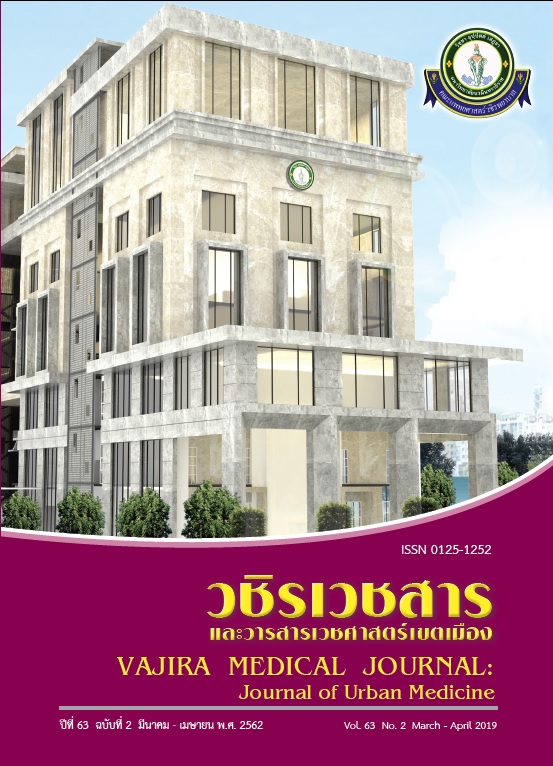The Actual Conditions of Clinical Education Management in Accordance with the Perceptions and Expectations of Medical Students at the Faculty of Medicine Vajira Hospital, Navamindradhiraj University
Main Article Content
Abstract
Objective: To study and compare the perceptions and expectations of clinical education management, on instruction, lecturers and welfare of medical students at Faculty of Medicine Vajira Hospital, Navamindradhiraj University on the basis of gender, year of study and cumulative grade point average (GPA).
Methods: Participants were 150 fourth to sixth year medical students in 2017 academic year at Faculty of Medicine Vajira Hospital. They were asked to rate on clinical education management (instruction, lecturers and welfare) questionnaire. Independent sample t-test was used to compare if there was significant difference between perceptions and expectations.
Results: The perceptions and expectations on clinical education management at overall were high (mean= 3.69) and highest (mean=4.5) level, respectively. The medical student expectations were higher than perceptions on instruction, lectures and welfare (p< 0.05). The medical student perceptions were not different, on the basis of gender and GPA, except the 6th year medical student perceptions were higher than 4th and 5th year students on welfare domain (p< 0.05).
Conclusion: The perceptions of medical students on clinical education management were high except moderate on welfare. There were significant difference between the perceptions and expectations of medical students across three domains.
Downloads
Article Details
References
2. History of Consortium of Thai Medical Schools. Available at: www.cotmes.net. Retrieved January 15, 2017.
3. Announcement of The Medical Council of Thailand No.12/2560. Available at: https://www.tmc.or.th /pdf/tmc_file12-2560.pdf. Retrieved January 15, 2017.
4. Nuallaong W. Quality of life Predicting Factors among the First Year Medical Students. J Psychlatr Assoc Thai. 2012; 57(2):227.
5. Boonlerdkerdkrai W, Kraysubun C. Stress Factors and Quality of life among the Clinical Year Medical Students: Chaophya Abhaibhubejhr Hospital New Medical Education Center. BJM 2015;2:4-14.
6. Apiwatanasiri C, Somaketrarin K, Suraprayoon K, Leurmprasert K, Wankaew N, Homchampa P, ed al. Stress and Coping in Medical Students at Clinical Level, Khon Kaen University. Srinagarind Med J 2007; 22(4):416-24.
7. Kamlungkuea T, Kositkuljorn C, Sukhato K. Medical Students’ Perceptions of Ward Rounds in the Undergraduate Medical Curriculum. Ramathibodi Medical Journal 2018; 41: 48-57.
8. Nuallaong W. How to instruct the Generation Y medical students. Thammasat Medical Journal, 2010; 10(3): 381-85.
9. Cohen L, Manion L, Morrison K. Research Method in Education 7th ed. NewYork, Rotledge; 2011. P.147.
10. Toopraka D. Effects of Context Based Learning Education Management on Attitude of Research and Community practice of 4th Year Medical Students [Internet]. [cited 2017 Dec 2]; Availale from: HYPERLINK “http://teachingresources.psu.ac.th/%20files/research/” http://teachingresources.psu.ac.th/files/research/CPIRD2016/O04MD.pdf.
11. Hongliam N, Odompet P, Poomjan P. The study of attitude of pre-clinical medical students to teaching and learning in Doctor of Medicine Program, Faculty of Medicine Siriraj Hospital. Siriraj Medical Bulletin 2015; 8(1):10-18.
12. Wenrich M, Jackson MB, Scherpbier AJ, Wolfhagen IH, Ramsey PG, Goldstein EA. Ready or not? Expectations of faculty and medical students for clinical skills preparation for clerkships. Med Educ Online 2010;15. doi: 10.3402/meo.v15i0.5295.
13. Lempp H, Seale C. The hidden curriculum in undergraduate medical education: qualitative study of medical students' perceptions of teaching. BMJ. 2004; 329(7469): 770–773. doi: 10.1136/bmj.329.7469.770 . [cited 2016 Sep 15]; Available from: https://www.ncbi.nlm.nih.gov/pmc/ articles/PMC520997.
14. Palangrit S. Learning experience management for the 21st century. Thammasat Medical journal 2014; 14(3):443-47.
15. Pakorn J. The Opinions of Students about Residence Hall Services at King Mongkut’s University of Technology Thonburi. Master Thesis, Bangkok: Graduate School, Srinakharinwirot University; 2014.
16. Klongklew M. The study of needed factor for mobile learning at Graduate school of eLearning, Assumption University. Veridian E-Journal, Slipakorn University 2015; 8(2):2191-98.


